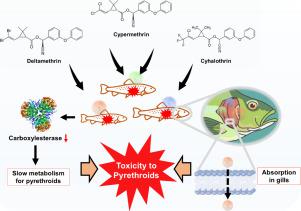当前位置:
X-MOL 学术
›
Comp. Biochem. Physiol. C Toxicol. Pharmacol.
›
论文详情
Our official English website, www.x-mol.net, welcomes your feedback! (Note: you will need to create a separate account there.)
Mediation of oxidative stress toxicity induced by pyrethroid pesticides in fish.
Comparative Biochemistry and Physiology C: Toxicology & Pharmacology ( IF 3.9 ) Pub Date : 2020-04-11 , DOI: 10.1016/j.cbpc.2020.108758 Changwon Yang 1 , Whasun Lim 2 , Gwonhwa Song 1
Comparative Biochemistry and Physiology C: Toxicology & Pharmacology ( IF 3.9 ) Pub Date : 2020-04-11 , DOI: 10.1016/j.cbpc.2020.108758 Changwon Yang 1 , Whasun Lim 2 , Gwonhwa Song 1
Affiliation

|
Organophosphate and organochlorine pesticides are banned in most countries because they cause high toxicity and bioaccumulation in non-target organisms. Pyrethroid pesticides have been applied to agriculture and aquaculture since the 1970s to replace traditional pesticides. However, pyrethroids are approximately 1000 times more toxic to fish than to mammals and birds. Fish-specific organs such as the gills and their late metabolic action against this type of pesticide make fish highly susceptible to the toxicity of pyrethroid pesticides. Oxidative stress plays an important role in the neurological, reproductive, and developmental toxicity caused by pyrethroids. Deltamethrin, cypermethrin, and lambda-cyhalothrin are representative pyrethroid pesticides that induce oxidative stress in tissues such as the gills, liver, and muscles of fish and cause histopathological changes. Although they are observed in low concentrations in aquatic environments such as rivers, lakes, and surface water they induce DNA damage and apoptosis in fish. Pyrethroid pesticides cause ROS-mediated oxidative stress in fish species including carp, tilapia, and trout. They also cause lipid peroxidation and alter the state of DNA, proteins, and lipids in the cells of fish. Moreover, changes in antioxidant enzyme activity following pyrethroid pesticide exposure make fish more susceptible to oxidative stress caused by environmental pollutants. In this review, we examine the occurrence of pyrethroid pesticides in the aquatic environment and oxidative stress-induced toxicity in fish exposed to pyrethroids.
中文翻译:

拟除虫菊酯类农药在鱼类中引起的氧化应激毒性的介导。
在大多数国家,有机磷和有机氯农药被禁止使用,因为它们在非目标生物体中引起高毒性和生物蓄积性。自1970年代以来,拟除虫菊酯农药已用于农业和水产养殖,以取代传统农药。但是,拟除虫菊酯对鱼类的毒性比对哺乳动物和鸟类的毒性高约1000倍。-等鱼类特有的器官及其对这种农药的后期代谢作用使鱼类对拟除虫菊酯农药的毒性高度敏感。氧化应激在拟除虫菊酯引起的神经,生殖和发育毒性中起重要作用。溴氰菊酯,氯氰菊酯和λ-氯氟氰菊酯是代表性的拟除虫菊酯农药,可在in,肝脏,和鱼的肌肉并引起组织病理学改变。尽管在河流,湖泊和地表水等水生环境中观察到它们的浓度很低,但它们会诱导DNA的损伤和鱼类的凋亡。拟除虫菊酯农药在包括鲤鱼,罗非鱼和鳟鱼在内的鱼类中引起ROS介导的氧化应激。它们还会引起脂质过氧化,并改变鱼细胞中DNA,蛋白质和脂质的状态。而且,暴露于拟除虫菊酯杀虫剂后抗氧化酶活性的变化使鱼类更容易受到环境污染物引起的氧化应激的影响。在这篇综述中,我们研究了拟除虫菊酯类农药在水生环境中的发生以及氧化应激引起的拟除虫菊酯类鱼类的毒性。尽管在河流,湖泊和地表水等水生环境中观察到它们的浓度很低,但它们会诱导DNA的损伤和鱼类的凋亡。拟除虫菊酯农药在包括鲤鱼,罗非鱼和鳟鱼在内的鱼类中引起ROS介导的氧化应激。它们还会引起脂质过氧化,并改变鱼细胞中DNA,蛋白质和脂质的状态。而且,暴露于拟除虫菊酯杀虫剂后抗氧化酶活性的变化使鱼类更容易受到环境污染物引起的氧化应激的影响。在这篇综述中,我们研究了拟除虫菊酯类农药在水生环境中的发生以及氧化应激引起的拟除虫菊酯类鱼类的毒性。尽管在河流,湖泊和地表水等水生环境中观察到它们的浓度很低,但它们会诱导DNA的损伤和鱼类的凋亡。拟除虫菊酯农药在包括鲤鱼,罗非鱼和鳟鱼在内的鱼类中引起ROS介导的氧化应激。它们还会引起脂质过氧化,并改变鱼细胞中DNA,蛋白质和脂质的状态。而且,暴露于拟除虫菊酯杀虫剂后抗氧化酶活性的变化使鱼类更容易受到环境污染物引起的氧化应激的影响。在这篇综述中,我们研究了拟除虫菊酯类农药在水生环境中的发生以及氧化应激引起的拟除虫菊酯类鱼类的毒性。拟除虫菊酯农药在包括鲤鱼,罗非鱼和鳟鱼在内的鱼类中引起ROS介导的氧化应激。它们还会引起脂质过氧化,并改变鱼细胞中DNA,蛋白质和脂质的状态。而且,暴露于拟除虫菊酯杀虫剂后抗氧化酶活性的变化使鱼类更容易受到环境污染物引起的氧化应激的影响。在这篇综述中,我们研究了拟除虫菊酯类农药在水生环境中的发生以及氧化应激引起的拟除虫菊酯类鱼类的毒性。拟除虫菊酯农药在包括鲤鱼,罗非鱼和鳟鱼在内的鱼类中引起ROS介导的氧化应激。它们还会引起脂质过氧化,并改变鱼细胞中DNA,蛋白质和脂质的状态。而且,暴露于拟除虫菊酯杀虫剂后抗氧化酶活性的变化使鱼类更容易受到环境污染物引起的氧化应激的影响。在这篇综述中,我们研究了拟除虫菊酯类农药在水生环境中的发生以及氧化应激引起的拟除虫菊酯类鱼类的毒性。拟除虫菊酯类农药接触后抗氧化酶活性的变化使鱼类更容易受到环境污染物引起的氧化应激的影响。在这篇综述中,我们研究了拟除虫菊酯类农药在水生环境中的发生以及氧化应激引起的拟除虫菊酯类鱼类的毒性。暴露于拟除虫菊酯农药后抗氧化酶活性的变化使鱼类更容易受到环境污染物引起的氧化应激的影响。在这篇综述中,我们研究了拟除虫菊酯类农药在水生环境中的发生以及氧化应激引起的拟除虫菊酯类鱼类的毒性。
更新日期:2020-04-20
中文翻译:

拟除虫菊酯类农药在鱼类中引起的氧化应激毒性的介导。
在大多数国家,有机磷和有机氯农药被禁止使用,因为它们在非目标生物体中引起高毒性和生物蓄积性。自1970年代以来,拟除虫菊酯农药已用于农业和水产养殖,以取代传统农药。但是,拟除虫菊酯对鱼类的毒性比对哺乳动物和鸟类的毒性高约1000倍。-等鱼类特有的器官及其对这种农药的后期代谢作用使鱼类对拟除虫菊酯农药的毒性高度敏感。氧化应激在拟除虫菊酯引起的神经,生殖和发育毒性中起重要作用。溴氰菊酯,氯氰菊酯和λ-氯氟氰菊酯是代表性的拟除虫菊酯农药,可在in,肝脏,和鱼的肌肉并引起组织病理学改变。尽管在河流,湖泊和地表水等水生环境中观察到它们的浓度很低,但它们会诱导DNA的损伤和鱼类的凋亡。拟除虫菊酯农药在包括鲤鱼,罗非鱼和鳟鱼在内的鱼类中引起ROS介导的氧化应激。它们还会引起脂质过氧化,并改变鱼细胞中DNA,蛋白质和脂质的状态。而且,暴露于拟除虫菊酯杀虫剂后抗氧化酶活性的变化使鱼类更容易受到环境污染物引起的氧化应激的影响。在这篇综述中,我们研究了拟除虫菊酯类农药在水生环境中的发生以及氧化应激引起的拟除虫菊酯类鱼类的毒性。尽管在河流,湖泊和地表水等水生环境中观察到它们的浓度很低,但它们会诱导DNA的损伤和鱼类的凋亡。拟除虫菊酯农药在包括鲤鱼,罗非鱼和鳟鱼在内的鱼类中引起ROS介导的氧化应激。它们还会引起脂质过氧化,并改变鱼细胞中DNA,蛋白质和脂质的状态。而且,暴露于拟除虫菊酯杀虫剂后抗氧化酶活性的变化使鱼类更容易受到环境污染物引起的氧化应激的影响。在这篇综述中,我们研究了拟除虫菊酯类农药在水生环境中的发生以及氧化应激引起的拟除虫菊酯类鱼类的毒性。尽管在河流,湖泊和地表水等水生环境中观察到它们的浓度很低,但它们会诱导DNA的损伤和鱼类的凋亡。拟除虫菊酯农药在包括鲤鱼,罗非鱼和鳟鱼在内的鱼类中引起ROS介导的氧化应激。它们还会引起脂质过氧化,并改变鱼细胞中DNA,蛋白质和脂质的状态。而且,暴露于拟除虫菊酯杀虫剂后抗氧化酶活性的变化使鱼类更容易受到环境污染物引起的氧化应激的影响。在这篇综述中,我们研究了拟除虫菊酯类农药在水生环境中的发生以及氧化应激引起的拟除虫菊酯类鱼类的毒性。拟除虫菊酯农药在包括鲤鱼,罗非鱼和鳟鱼在内的鱼类中引起ROS介导的氧化应激。它们还会引起脂质过氧化,并改变鱼细胞中DNA,蛋白质和脂质的状态。而且,暴露于拟除虫菊酯杀虫剂后抗氧化酶活性的变化使鱼类更容易受到环境污染物引起的氧化应激的影响。在这篇综述中,我们研究了拟除虫菊酯类农药在水生环境中的发生以及氧化应激引起的拟除虫菊酯类鱼类的毒性。拟除虫菊酯农药在包括鲤鱼,罗非鱼和鳟鱼在内的鱼类中引起ROS介导的氧化应激。它们还会引起脂质过氧化,并改变鱼细胞中DNA,蛋白质和脂质的状态。而且,暴露于拟除虫菊酯杀虫剂后抗氧化酶活性的变化使鱼类更容易受到环境污染物引起的氧化应激的影响。在这篇综述中,我们研究了拟除虫菊酯类农药在水生环境中的发生以及氧化应激引起的拟除虫菊酯类鱼类的毒性。拟除虫菊酯类农药接触后抗氧化酶活性的变化使鱼类更容易受到环境污染物引起的氧化应激的影响。在这篇综述中,我们研究了拟除虫菊酯类农药在水生环境中的发生以及氧化应激引起的拟除虫菊酯类鱼类的毒性。暴露于拟除虫菊酯农药后抗氧化酶活性的变化使鱼类更容易受到环境污染物引起的氧化应激的影响。在这篇综述中,我们研究了拟除虫菊酯类农药在水生环境中的发生以及氧化应激引起的拟除虫菊酯类鱼类的毒性。


























 京公网安备 11010802027423号
京公网安备 11010802027423号